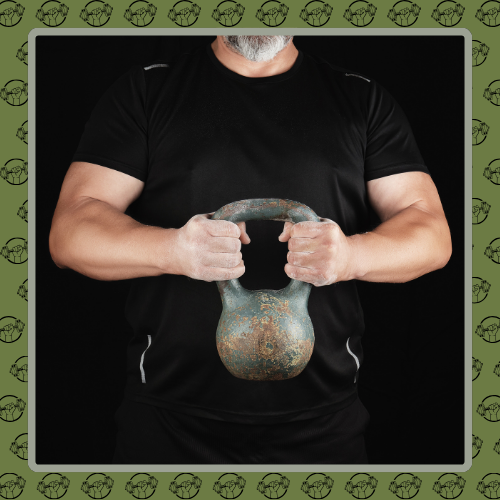Are you looking to maximize your strength and endurance? Look no further than the Farmer’s Walk exercise. The Farmer’s Walk is a full-body workout that primarily targets your core, lower body, and upper body muscles while improving your posture and stability.
This blog delves into everything you need to know about the Farmer’s Walk exercise. From understanding the basics of the exercise, avoiding common mistakes, setting up your own routine, and incorporating variations in your workout, we have you covered.
We also discuss the benefits of incorporating Farmer’s Walk in your fitness regime, including improved strength, endurance, and weight loss. So grab your weights and let’s get started on building a stronger you with the Farmer’s Walk exercise!

Understanding the Farmer’s Walk Exercise
Enhancing grip strength and core stability, the farmer’s walk exercise engages multiple muscle groups for a full-body workout. It effectively targets the upper back, shoulder blades, and quadratus lumborum.
Proper form and posture are crucial in its execution, ensuring maximum benefits. This exercise, rooted in strongman competitions and exercise science, complements leg exercises like squats, deadlifts, lunges, and the yoke walk. When performed properly, the farmer’s walk provides significant strength gains, making it a valuable addition to any fitness routine.
Basics of the Farmer’s Walk
Walking with heavyweights for a distance or time is the essence of the farmer’s walk. Whether using dumbbells, barbells, or trap bars, this exercise develops endurance, grip strength, and mental toughness.
It also demands bracing and core stability to carry heavy loads, improving work capacity and overall conditioning. Incorporating NLP terms such as “strongman competitions” and “bracing” will enhance the content.
Common Mistakes to Avoid
When engaging in the farmer’s walk exercise, it’s crucial to steer clear of using straps. Opting out of straps enhances grip strength, a key component of the exercise. Another common mistake is failing to maintain an upright posture, which can lead to strain on the lower back. Beginners should initiate their training with lighter weights to master the proper form before progressing to much weight. Ensuring a strong grip and emphasizing core bracing are fundamental for safety and effectiveness during the farmer’s walk, thereby avoiding potential cons.
Setting Your Farmers Walk Routine
Determine the appropriate sets and reps based on your individual strength training goals to maximize the benefits of the farmer’s walk exercise. Align the frequency of your farmer’s walk workouts with your overall training program.
Emphasize heavier weights during the exercise to promote muscle hypertrophy and enhance grip strength and endurance. Incorporating farmer’s walk routines into your workouts will not only benefit specific muscle groups but also contribute to overall athleticism and coordination.
Determining Sets and Reps
Optimizing farmer’s walk training involves gradually increasing weight with a focus on proper form. This progressive overload promotes muscle mass and strength. Varying sets and reps challenges different muscle groups effectively, while proper bracing ensures core stability and endurance, especially with heavier weights.
It’s essential to adjust sets and reps based on muscle group targeting and desired hypertrophy, ensuring a well-rounded approach to farmer’s walk routines.
How Often Should You Do Farmer’s Walk?
To maximize the benefits of the farmer’s walk exercise, the frequency of your workouts will depend on your training objectives and recovery. Regularly incorporating this exercise can help build work capacity and strength endurance. However, it’s important to balance the frequency to prevent overtraining and optimize grip strength, muscle endurance, and overall athletic performance.

Variations of the Farmer’s Walk
Suitcase carry variations effectively target the obliques, enhancing core strength and stability. The trap-bar farmer’s walk exercise provides a versatile grip, targeting different muscle groups.
Overhead unilateral carry presents a challenge for shoulder stability, coordination, and grip strength.
Utilizing heavier weights in farmer’s walk variations promotes significant strength and hypertrophy gains.
These variations offer an effective lower body and grip strength workout, aligning with the objectives of strongman competitions and exercise science.

Suitcase Carry
Improving grip strength, endurance, and core stability, suitcase carry variations offer a simple yet effective exercise for full-body strength training.
Engaging the entire body, this unilateral exercise enhances strength and coordination. Gradually incorporating heavier loads challenges obliques, grip strength, and mental toughness while emphasizing bracing, posture, and core engagement.
Suitcase carry variations are a valuable addition to any workout routine, promoting overall physical performance and well-being.
Trap-Bar Farmer’s Walk
Targeting the lower body, the trap-bar farmer’s walk exercise enhances leg strength and stability. By using heavier weights, this exercise promotes muscle hypertrophy and overall strength, challenging grip endurance.
Including trap-bar farmer’s walk variations in training provides a comprehensive full-body workout, improving muscle coordination. Emphasizing proper bracing and posture during the exercise is crucial for injury prevention.
This exercise provides a valuable addition to any workout routine, effectively targeting various muscle groups and promoting overall strength and stability.

Overhead Unilateral Carry
Enhancing shoulder stability, grip strength, and core engagement, the overhead unilateral carry offers a comprehensive upper body and core workout. This exercise challenges coordination, promoting full-body strength and stability.
By gradually increasing weights, you can effectively target deltoids, triceps, and core muscles. Variations of the overhead unilateral carry further intensify the workout, making it an essential component of any strength training regimen.
Farmer’s Walk: Muscles Targeted
Targeting grip strength, upper back, and the entire body, the farmer’s walk is a loaded carry that engages the external obliques and shoulder blades, challenging core stability.
This full-body exercise works the lower body, upper body, and core, benefiting muscle group endurance. Incorporating farmer’s walk in a training program can enhance overall strength and stability.
The exercise science behind the farmer’s walk promotes strongman competitions and is considered a fundamental exercise in maximizing strength and endurance.

Core and Lower Body Muscles
Strengthening the core, hamstrings, and glutes, the farmer’s walk exercise also works the quadriceps, calves, and quadratus lumborum. It enhances core stability, bracing, and posture, requiring a strong grip, coordination, and mental toughness.
This exercise effectively challenges core strength, lower body endurance, and grip strength, making it a valuable addition to any workout routine.
Upper Body Muscles
Targeting shoulder, forearm, triceps, and biceps strength, the farmer’s walk exercise is a solid choice for enhancing upper body muscle mass and shoulder stability.
Additionally, it engages the upper back, traps, and grip strength, offering benefits for forearm, triceps, and overall upper body stability.
Moreover, the exercise contributes to strengthening grip, shoulder, and upper body hypertrophy, making it an essential component in any comprehensive strength training regimen.
Gaining from the Farmer’s Walk
Farmer’s walk offers a multitude of benefits including enhanced strength, endurance, full body engagement, and improved posture. Incorporating this exercise into your training regimen can significantly boost work capacity and muscle mass.
Additionally, the farmer’s walk routine is highly effective in improving grip strength, core stability, and overall endurance. It also presents a unique challenge to mental toughness, coordination, and upper back stability while simultaneously promoting better posture and increased grip strength.
Strength and Endurance Benefits
Enhancing strength, grip strength, and muscle endurance is a notable outcome of the farmer’s walk. This exercise also fosters improvements in grip strength, work capacity, and muscle mass. Additionally, it challenges strength, endurance, and coordination among muscle groups, leading to enhanced core stability and mental toughness.
Furthermore, incorporating farmer’s walk training into a workout routine can promote grip strength, muscle endurance, and overall full-body strength, making it an essential component for individuals seeking to maximize their physical performance.
Postural Improvements and Stability
Enhancing posture, core stability, and upper back strength occurs through the farmer’s walk exercise. Grip strength, posture, and core stability all benefit from this strength training. The farmer’s walk poses challenges to posture, grip strength, and core stability, leading to improved endurance in core stability.
Ultimately, the farmer’s walk contributes to improved posture, enhanced grip strength, and increased stability in the upper back.
Farmer’s Walk for Weight Loss
Enhancing weight loss, conditioning, and cardio endurance, the farmer’s walk exercise is a valuable addition to any workout routine. Its training program promotes endurance, full body conditioning, and work capacity.
This exercise contributes to weight loss and muscle endurance, while also improving overall conditioning and cardio endurance. Leveraging the benefits of strongman competitions and exercise science, the farmer’s walk is an effective way to enhance weight loss goals and improve overall fitness levels.
Incorporating Farmer’s Walk in Your Workout
Adding farmer’s walk to your workout routine brings simplicity, strongman conditioning, and muscle endurance. This exercise enhances grip strength, lower body work, and strong grip conditioning.
It benefits grip strength, conditioning, and mental toughness, adding work capacity, conditioning, and heavy weight training. The farmer’s walk also promotes strength, conditioning, and muscle endurance, aligning with exercise science and the principles of much weight and leg exercise.
Farmer’s Walk in a Hypertrophy Routine
Incorporating the farmer’s walk into a hypertrophy routine can significantly contribute to muscle group hypertrophy, core stability, and coordination. This exercise enhances muscle mass, hypertrophy, and body weight conditioning, while also improving grip strength and overall conditioning.
Additionally, it promotes muscle hypertrophy, grip strength, and full-body coordination, making it a valuable addition to any hypertrophy-focused training program. By including the farmer’s walk in your routine, you can effectively target multiple muscle groups and achieve comprehensive hypertrophy.
Farmer’s Walk for Conditioning
The farmer’s walk exercise is a robust method for enhancing strength conditioning, muscle endurance, and overall full body capacity. It is particularly effective in improving grip strength, endurance, and work capacity.
This workout provides a unique challenge for muscle endurance, grip strength, and full body conditioning, making it an excellent addition to any training regimen aimed at improving conditioning, grip strength, and muscle endurance.
The farmer’s walk contributes significantly to overall conditioning, work capacity, and full body endurance, making it a valuable exercise in any fitness routine.
Variations of the Farmer’s Walk
Suitcase carry variations effectively target the obliques, enhancing core strength and stability. The trap-bar farmer’s walk exercise provides a versatile grip, targeting different muscle groups.
Overhead unilateral carry presents a challenge for shoulder stability, coordination, and grip strength.
Utilizing heavier weights in farmer’s walk variations promotes significant strength and hypertrophy gains.
These variations offer an effective lower body and grip strength workout, aligning with the objectives of strongman competitions and exercise science.

Suitcase Carry
Improving grip strength, endurance, and core stability, suitcase carry variations offer a simple yet effective exercise for full-body strength training.
Engaging the entire body, this unilateral exercise enhances strength and coordination. Gradually incorporating heavier loads challenges obliques, grip strength, and mental toughness while emphasizing bracing, posture, and core engagement.
Suitcase carry variations are a valuable addition to any workout routine, promoting overall physical performance and well-being.
Trap-Bar Farmer’s Walk
Targeting the lower body, the trap-bar farmer’s walk exercise enhances leg strength and stability. By using heavier weights, this exercise promotes muscle hypertrophy and overall strength, challenging grip endurance.
Including trap-bar farmer’s walk variations in training provides a comprehensive full-body workout, improving muscle coordination. Emphasizing proper bracing and posture during the exercise is crucial for injury prevention.
This exercise provides a valuable addition to any workout routine, effectively targeting various muscle groups and promoting overall strength and stability.

Overhead Unilateral Carry
Enhancing shoulder stability, grip strength, and core engagement, the overhead unilateral carry offers a comprehensive upper body and core workout. This exercise challenges coordination, promoting full-body strength and stability.
By gradually increasing weights, you can effectively target deltoids, triceps, and core muscles. Variations of the overhead unilateral carry further intensify the workout, making it an essential component of any strength training regimen.
FAQs
What is the farmer’s walk exercise and what muscles does it work?
The farmer’s walk exercise involves carrying heavy weights in each hand while walking. It targets the muscles in your grip, forearms, upper back, shoulders, and core. This functional exercise can improve overall strength and endurance.
How often should I include the farmer’s walk in my workout routine?
Consider your fitness goals and current strength level to determine the frequency of farmer’s walk in your workout routine. Beginners can start with 1-2 sets per week, while advanced lifters can include it up to 3-4 times a week.
Remember to allow for rest days and gradually increase weight and distance covered.
Are there any variations of the farmer’s walk exercise?
Yes, there are several variations of the farmer’s walk exercise. These include using different weights, holding the weights in different positions, or adding obstacles to the course. The variation you choose will depend on your fitness goals and experience level. Consult a trainer or fitness expert for guidance on the best variation for you.
What are some benefits of incorporating the farmer’s walk into my fitness regimen?
Incorporating the farmer’s walk into your fitness regimen offers numerous benefits. This full-body exercise engages multiple muscle groups and improves grip strength, core stability, and endurance. It also enhances posture and balance and can be done with minimal equipment.
What equipment do I need for the farmer’s walk exercise?
You will need two heavy dumbbells or kettlebells of equal weight to perform the farmer’s walk exercise. Make sure to use proper grip gloves or straps for a secure hold and to prevent injury. Wear comfortable athletic shoes with good traction for stability. Find a flat, open space with enough room to walk several yards.
Set Your Schedule and Begin
The Farmer’s Walk exercise is a versatile and effective strength and endurance builder. It targets multiple muscle groups in both the upper and lower body, while also improving core stability and posture.
Whether you’re looking to gain strength, improve your conditioning, or even lose weight, the Farmer’s Walk can be a valuable addition to your workout routine. When incorporating the Farmer’s Walk into your training, it’s important to determine the appropriate sets and reps based on your fitness level and goals.
Additionally, choosing the right equipment and gradually increasing the weight will help you progress safely and effectively. So, lace up your shoes, grab those weights, and start maximizing your strength and endurance with the Farmer’s Walk.

